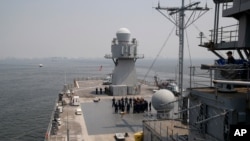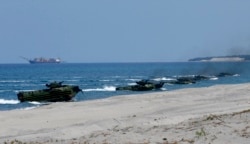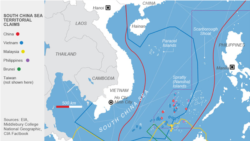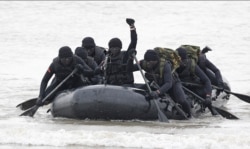U.S. President Donald Trump is getting more aggressive toward Chinese activity in a disputed Asian sea compared to his predecessors, because the U.S. government fears China has expanded too far to overlook, analysts in the region believe.
The U.S. government has stepped up military support over the past two years for countries that contest Chinese claims to the South China Sea. In one recent case, on May 23, officials in the Philippines said they planned to acquire U.S.-made P-3 “Orion” surveillance and anti-submarine aircraft after the United States retires them.
U.S. Navy ships have also sailed the South China Sea 11 times under Trump as part of a program called Freedom of Navigation Operation, or FONOP. The ships monitor Chinese activity and are quietly welcomed by China’s rivals in Asia.
“I’m not sure Trump sees the South China Sea differently than his predecessors did, but things have certainly been getting worse there year by year, as Beijing reclaims more land and further militarizes its assets,” said Sean King, vice president of Park Strategies political consultancy in New York. “Trump’s FONOPs are in fact, maybe, too little too late.”
Perception of urgency
Former U.S. president Barack Obama sent Navy ships to the South China Sea six times to monitor Chinese activity there, but during his eight-year term ending in 2017 China controlled less land in the sea and a world arbitration court was hearing a case on the legal basis for Chinese maritime sovereignty. China lost the case in 2016 but said it would ignore the ruling.
Brunei, Malaysia, Taiwan, Vietnam and the Philippines, all militarily weaker than China, contest Beijing’s claims to the 3.5 million-square-kilometer sea that’s valued for fisheries and energy reserves. China cites historical records to back its claims to about 90% of the sea. Over the past decade, China has landfilled tiny islets for military use, alarming other countries.
“I think the United States is already very late in terms of showing their interest and determination to maintain its presence in the South China Sea,” said Alexander Huang, strategic studies professor at Tamkang University in Taiwan. “The reality is that the United States did not do enough in terms of stopping China’s land reclamation and occupation or militarization of the South China Sea artificial islands.”
To step up pressure on China, the Trump government is working more than previous administrations with Western-allied navies from Japan and Australia into Western Europe. Those countries now send their own navy vessels to the South China Sea, drawing angry responses from Beijing as meddling in Asian affairs.
This month, the Royal Canadian Navy and Japan’s Maritime Self Defense Force carried out drills together in sea. As under Obama, the Trump government periodically holds joint military exercises with the Philippines, as well.
U.S. allies hope to halt continuing Chinese expansion in the sea, said Stephen Nagy, senior associate politics and international studies professor at International Christian University in Tokyo.
“My understanding of the current administration in the U.S. is that there’s a clear consensus that the Obama administration didn’t do enough of the FONOPs and that the increased number and breadth of the FONOPs is representative of a general shift in Washington, not just a Trump administration shift, that it was important to increase the number of FONOPs to push back against the Chinese,” Nagy said.
Ripple effects
U.S. officials are increasing pressure on China largely to answer a relatively “assertive” Chinese president, Xi Jinping, he added. The United States now hopes to “change Chinese behavior” on security and trade, he said.
The U.S. government “seeks progress on areas of disagreement such as China’s territorial claims in the South China Sea,” the State Department said on its website in August.
U.S. ships began passing regularly through the Taiwan Strait over the last year, too, a likely show of support for democratic Taiwan over China, which claims the island as its own despite 70 years of self-rule. China protests the passages.
And Trump’s 348-day-old trade dispute with China shows little sign of abating despite discussion this year about reaching a deal. Trump tweeted last month that the United States “lost” a trade war that began 30 years ago and that “this is a bright new Age.”
Trump appears “more direct” and “more not afraid to back down” against China compared to other U.S. presidents, said Termsak Chalermpalanupap, fellow with the ISEAS Yusof Ishak Institute in Singapore.
“It’s just to show that China cannot always have what China wants, even in (the) South China Sea,” Chalermpalanupap said. “I think it’s good in the sense that it makes Chinese calculations more complicated. They cannot just assume that (the) U.S. will back down everywhere, and now we can see in the trade war that the U.S. is not backing down.”








